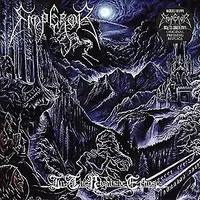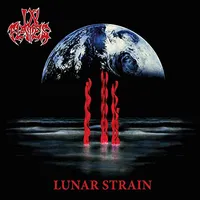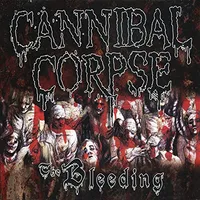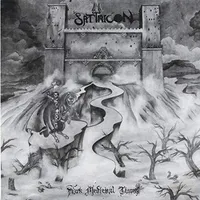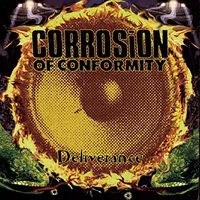1994: The albums that changed the world
1994 was the year when metal came of age, bands twisting heavy music into new forms that would echo through the ages. We take a look back at the year's essential releases
Machine Head - Burn My Eyes
In a year of game-changing albums, Burn My Eyes was truly one for the ages. Inspired by riots, religious cults and a desire to push the boundaries of heavy music, its impact was nothing short of monstrous.
Released by Roadrunner Records on August 9, 1994, it was hailed as an instant classic and became the label’s biggest-selling debut ever (an accolade it retained until Slipknot’s breakthrough in ’99).
With its ground-breaking blend of thuggish grooves, vicious thrash and hip hop bravado, not to mention frontman Robb Flynn’s incendiary lyrics, Burn My Eyes did more than most to redefine metal in the 90s.
Recorded at Berkeley’s Fantasy Studios, and produced by legendary metal guru Colin Richardson, Burn My Eyes’ ultra-modern metal anthems perfectly encapsulated both Robb’s intense focus and the self-inflicted chaos of the young band’s lives.
With enough old-school bite to keep the thrash contingent happy and vast quantities of contemporary punch and invention, Burn My Eyes made a decent fist of uniting metal's various tribes.
The album’s impact was immediate, particularly in the UK and Europe, but until those sales figures rolled in, Robb remained unsure whether the band had a bright future. But 25 years on, few fans – nor Robb himself – would dispute the enduring power of an album which went on to truly change the mould.
Emperor - In The Nightside Eclipse
Norwegian black metal in the early 90s was a far different beast to the polished, unit-shifting phenomenon we’re used to these days. Churches were burned to the ground; graves were desecrated; and at least three homicides were connected with the scene.
At the centre of the soon-to-be-circus were Emperor. But with their 1994 debut album, black metal’s leading lights grew up quickly, bringing symphonic ambition to the crepuscular murk.
Not many people will argue against the case that Emperor are the greatest black metal band of all time, or that they raised the genre into new realms of art. In The Nightside Eclipse amplified black metal’s invocation of otherness as it imprinted the inhuman on an immeasurably vast and majestic canvas.
Keyboards swirled like avenging angels of death, guitars surged as if attempting to reach escape velocity from this mortal realm and Emperor tore open new spaces that drew in innumerable voyagers in their wake.
Acid Bath - When The Kite String Pops
There were a load of sublimely heavy bands that came from the stifling heat of the New Orleans scene in the early 90s, but perhaps the most notorious was Acid Bath. Despite only existing as a band for a mere six-year period, they created a back catalogue of such depraved, pain-inducing sludge metal that they remain a true underground cult act, all these years later. Their debut album, When The Kite String Pops, continues to set a high watermark for the genre, alongside the work of their peers and contemporaries such as Eyehategod and Crowbar.
There was something fascinatingly disturbing and unnerving about When The Kite String Pops. It could have been the chilling front cover image of Pogo The Clown, the alter ego of serial killer John Wayne Gacy, as painted by the man himself. Alternatively, the use of clips from controversial films such as David Lynch’s Blue Velvet and Stanley Kubrick’s A Clockwork Orange, submerged by an oppressive slurry of metallic riffs, may be the thing that stirs up such unease. But, most likely, it was the images of sheer, visceral, violent disgust that vocalist Dax Riggs painted in songs such as What Color Is Death, Dope Fiend and Cheap Vodka.
There was some brief respite in Scream Of The Butterfly, when Acid Bath momentarily sounded like a traditional metal band, but, for the most part, WTKSPs was a terrifying and hellish listen. Acid Bath would only release one more album, 1996’s Paegan Terrorism Tactics, before disbanding following the tragic and senseless death of bassist Audie Pitre at the hands of a drunk driver, in 1997.
Over the years, as the sludge metal scene has grown and spread out around the world, Acid Bath’s status as innovators and godfathers of this style has increased, and When The Kite String Pops is a world-class example.
Prong - Cleansing
Prong were a decent, if not especially revolutionary, metal band at the start of 1994. But the combination of frontman Tommy Victor’s desire to move away from more standard thrash stylings and into more groove and industrial territories, plus the addition of former Killing Joke members Paul Raven and John Bechdel, changed all that. Cleansing remains their definitive album, full of throbbing rhythms and stabbing riffs that personify the 90s ‘rock club banger’ sound perfectly.
While it’s impossible to stop nodding your head to utter ragers such as Whose Fist Is This Anyway? or Broken Peace, the centrepiece of the record was undoubtedly the anthemic Snap Your Fingers, Snap Your Neck.
It appeared on an episode of Beavis And Butt-Head, where the duo were unusually positive about what they were seeing for once, and it was adopted by ECW wrestler Justin Credible for his entrance music – all of which turned it into a major crossover success. That opening bass bounce is still instantly recognisable to metal fans 25 years on.
It was a short stint in the public eye for Prong, who are still releasing excellent music to this day, but the quality of Cleansing is proof of just how deserved their success was.
Darkthrone - Transilvanian Hunger
Fuelled by an anger drawn from the turbulent events in both the black metal scene and the members’ personal lives, the utter fury of Transilvanian Hunger saw it immediately recognised as a raw, hateful classic. It helped that it featured one of black metal’s most famous covers, Fenriz’s candelabra scream echoing both Mayhem’s classic album Live In Leipzig and, dare we say it, The Scream by fellow Norwegian Edvard Munch.
Fenriz created almost the entire album, handling all instruments and half the lyrics (the rest were created by Burzum’s Count Grishnackh/Varg Vikernes, a move that angered many), the band having lost two of its members in as many albums. The band also sparked controversy by printing ‘Norsk Arisk Black Metal’ (‘Norwegian Aryan black metal’) on the back cover, and stating that anyone who criticised the record “should be thoroughly patronized for his obvious Jewish behaviour”, actions Fenriz has since categorically denounced.
But it was the last record released on Peaceville for many years. The band would be relaunched by Moonfog, the label of Satyricon mainman Satyr. Musically, Transilvanian Hunger stands as one of the most iconic albums in Darkthrone’s back catalogue and for 90s black metal.
In Flames - Lunar Strain
By the onset of 1994, the idea of injecting more melody into death metal wasn’t that new. The previous year heralded albums such as Heartwork from Britain’s Carcass, Individual Thought Patterns from Floridians Death, and The Spectral Sorrows from Sweden’s Edge Of Sanity – all of which gave death metal a harmonic edge. The genre’s intensity remained, but it was now coexisting with energised choruses and duelling, shredding guitars. This was death metal meets NWOBHM.
But the bands experimenting with these new sounds were separated by thousands of miles, with no close-knit geographical scene. In Flames helped change that. The quintet formed as teenagers in 1990, against the frosty backdrop of Gothenburg, Sweden. With a deep affinity for American thrash and Iron Maiden, they spent their nights playing gigs and their days drinking in parks, boomboxes in hand, alongside local contemporaries such as At The Gates and Dark Tranquillity.
On debut Lunar Strain, In Flames refined those loose blueprints provided by Carcass and Edge Of Sanity. They didn’t just have swanky guitars and hooky refrains; they introduced ominous acoustic passages, speeding breakdowns and existential lyrics befitting of their gothic hometown. The influence of Maiden’s twin guitar leads was strong, from powerful opener Behind Space to their namesake song In Flames. It was recorded at Studio Fredman, which would become the home of ‘the Gothenburg sound’, with vocals provided by Dark Tranquillity’s Mikael Stanne. That band’s previous singer, Anders Fridén, would go on to sing on In Flames’ subsequent records.
Over the next few years, melo-death rose to greatness in Sweden and beyond. Albums such as At The Gates’ seminal Slaughter Of The Soul, Dark Tranquillity’s The Gallery and In Flames’ own follow-up, The Jester Race, are timeless greats that followed in the slipstream of Lunar Strain.
Cannibal Corpse - The Bleeding
By the time 1994 rolled around, the majority of the success underground metal built through the late 80s/early 90s had been wiped away by The Great Unwashed From The City Of Seattle.
A remaining fraction of thrash and death metal warriors were fighting the good fight and putting out quality material, but a good chunk of the subterranean scene had been whittled away as metal became watered down and anaemic in the chase of grunge’s success.
With The Bleeding, Cannibal Corpse paid no heed to the Cobains, Cornells, Vedders, Staleys and other tortured artists of the world and just, er, tortured. The album’s comparatively docile cover art may have initially led the public to believe they’d inexplicably joined in that chase, but once laser hit electronically coded piece of plastic, it became evident the band were not only defying the industry’s popular sway, but had become one of the definitive acts – if not the defining act – of a genre surviving by the skin of its teeth. A couple of months earlier, they’d also had a boost from their appearance in Jim Carrey’s Ace Ventura: Pet Detective.
The songs comprising the band’s fourth album were triumphantly and brutally crushing, as they also nudged the goalposts back with technically adroit staccato riffing spells, vocals that flirted with grindcore’s mid-range screech and a firm sense of groove – all wrapped into well-structured, rock- solid compositions.
Times have changed since 1994, and titles such as Fucked With A Knife, Stripped, Raped And Strangled and She Was Asking For It would likely face serious backlash were they released today. But it’s a testament to the album’s staying power that these tracks and many others remain in the band’s present-day live set where young and old alike can be found banging heads and hollering along in salutation of, and participation in, Cannibal Corpse’s blood-soaked world.
Kyuss - Welcome To Sky Valley
In the sweltering depths of the Californian desert, something was stirring in the early 90s. A community of musicians, brought up on the stodgy sludge of classic Black Sabbath and the mind-warping psychedelia of The Doors, would routinely get together and have ‘generator parties’ in the heart of the desert. From that scene rose myriad stoner rock bands, but only one were the kings: Kyuss. Their legend was cemented on Welcome To Sky Valley, their third album and major label debut.
It’s impossible to emphasise just how monolithic the guitar riffs of Josh Homme sounded back in 1994, but the fact that Kyuss still sound like the rumble of an earthquake and the power of a tornado happening at once should give some insight into why …Sky Valley connected so strongly.
Whether it’s the gut-battering groove of Supa Scoopa And Mighty Scoop (with arguably the best false ending in metal), or the dry and stabbing liquid punk rock of 100˚, Welcome To Sky Valley was manna from heaven for fans of more traditional-sounding rock at a time when metal was truly evolving.
The fact that Kyuss not only managed to sound as exciting and contemporary as any other modern band, while leaning so heavily on the tropes of the past, but were clearly totally disinterested in playing the music business game, is why fans of the time still continue to speak about Welcome To Sky Valley in the sort of hushed tones reserved for gods and royalty. At this point in time, with their legend and legacy still intact, one listen to this should be enough to convince you that it’s justified.
Satyricon - Dark Medieval Times
Mayhem’s De Mysteriis Dom Sathanas might rightly be considered black metal’s foundational album, but the year of its release was no slouch in terms of raw material being forged elsewhere. There were seminal releases from Emperor, Darkthrone, Gorgoroth, Enslaved (two in their case) and Burzum for starters, not to mention numerous demos causing their own ripple effects throughout the scene.
Having released a couple of demos themselves over the previous two years, Satyricon released debut Dark Medieval Times worldwide in 1994 (swiftly followed by The Shadowthrone). It remains an important record in its own right: a supremely grim compendium of numerous themes and motifs that were swirling around black metal, from frigid symphonic sweeps, to fascination with medieval (obviously) ruin and the hallowed inhumanity of nature, but its true historical stature is as a marker point for where black metal would go next.
As with Ulver, it’s worth remembering that Satyricon’s current boundary-resistant incarnation has its roots in feral ultra-traditionalism, but as the first release on frontman Satyr Wongraven’s own Moonfog label, it was the ground zero for a new urban, futuristic take on black metal with which Moonfog became synonymous – a revolutionary aesthetic now as wedded to the scene as adamantium to Wolverine’s bones.
Corrosion Of Conformity - Deliverance
After a decade of existing in the hardcore underground, COC finally arrived in the mainstream with their major label debut, Deliverance. Their success was built on crafting an album that eschewed the blast and rumble of their early punk rock days and instead perfected the more groove-laden, Sabbath-worshipping and classic metal vibes that had started to creep in on 1991’s Blind.
Much of the credit goes to guitarist Pepper Keenan, who not only stepped up to the front musically, but also lent a wonderfully slack-jawed, Southern drawl to songs such as Broken Man on his first release fronting the band.
It spawned two massive hit singles; the anthemic chug of Clean My Wounds and the rolling, hulking sway of Albatross turned Corrosion Of Conformity into one of the hottest bands in the world of metal at that time. Truthfully, though, there is far more to the album than those two songs – the greasy title track and the nearly-seven-minute-long stoner freak-out of Pearls Before Swine are as good as anything COC ever put their name to. Deliverance remains a thoroughly classic album.
Sign up below to get the latest from Metal Hammer, plus exclusive special offers, direct to your inbox!
Chris has been writing about heavy metal since 2000, specialising in true/cult/epic/power/trad/NWOBHM and doom metal at now-defunct extreme music magazine Terrorizer. Since joining the Metal Hammer famileh in 2010 he developed a parallel career in kids' TV, winning a Writer's Guild of Great Britain Award for BBC1 series Little Howard's Big Question as well as writing episodes of Danger Mouse, Horrible Histories, Dennis & Gnasher Unleashed and The Furchester Hotel. His hobbies include drumming (slowly), exploring ancient woodland and watching ancient sitcoms.

